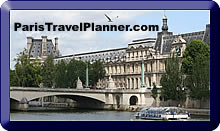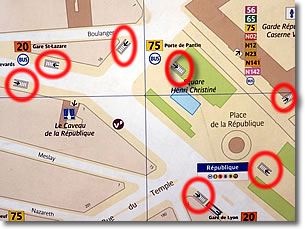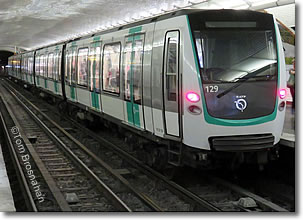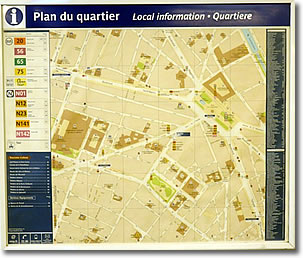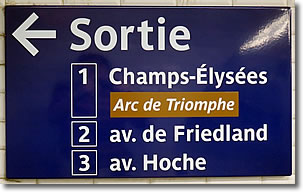|
|
|
Everybody knows how to use a city underground train (Metro, subway) system, right? Buy a ticket, choose a train, board, ride, arrive. Sure, you'll get there, but how many times will you stop, look around, wonder, walk the wrong way, walk back, go up and down stairs, feel perplexed, and be late for the rendez-vous you've arranged at the other end of the trip? Riding the train is the easy part. Walking to and from the train is where you get lost and confused. Get the Bonjour RATP App!We strongly suggest you obtain and use the excellent RATP transit app, Bonjour RATP. With it, you can plan your route door-to-door, get travel time estimates, buy tickets, learn of disruptions in service, learn which trains to take and where to stand on the platform in order to facilitate transfers to other lines. You'll learn which exit to use from your destination station—this is important at huge stations such as Châtelet or Charles-de-Gaulle-Étoile, which can have a dozen or more exits, some perhaps a 15-minute walk apart. More... Here's exactly how the Paris Métro is designed to be used most efficiently: To the Métro StationThis can be the easiest part: finding your way from where you are to the nearest Métro station. 1. Street & Métro System MapsUse the Bonjour RATP app, or get a good, detailed street map (paper or smartphone app) or pocket atlas of Paris which includes a Métro system map, and know how to identify Métro stations on the street map(s). More... 2. Plan Your RouteFind your present location on the map, then your destination, then follow the Métro lines on the Métro system plan to find the Métro lines that will take you there. Most trips require a change from one line to another at an interchange station. 3. Buy your ticket(s)Buy tickets and transit passes on your smartphone via the Bonjour RATP app. Your phone then becomes your ticket. Taking the Train(s)4. Note Your ItineraryMake a note (mental or written) of these details: —First Métro line to take, and the Destination (terminus, end of the line) toward which you want to travel. (For example, Line 4 from Gare du Nord toward the Destination of Mairie d'Issy, getting out at the Odéon station.) The Bonjour RATP app will tell you which part of the train to board (front, rear, etc) for easiest access to the next step of your journey.) —Interchange station, if any. (For example, Odéon.) —Next Métro line to take from the interchange station, and the Destination toward which you want to travel. (For example, Line 10 from Odéon, Destination Gare d'Austerlitz, getting out at the Cardinal Lemoine station.) The Bonjour RATP app will tell you which Sortie (exit) to take from your destination station to speed you on your way. Follow the signs to that exit. 5. Route to Departure StationDetermine exactly the walking route to your departure Métro station. As you enter the station, confirm that the station (or at least this entrance) serves the Métro line you want: look for the line number (usually in a colored circle):
Then, follow the signs to that line, passing through the entrance turnstiles with your ticket or pass. 6. Find Your Line & DestinationContinue to follow the signs to the line, which will now include the names of the Destinations (terminus stations). At some point the signs will indicate different walking routes to the different platforms for each Destination. Be sure you're following signs to the train toward the Destination you want or you'll end up going the wrong way on the train. 7. On the PlatformEvery train platform should have a wall map of the Métro system, a plan du quartier map of the neighborhood above ground, and in many stations electronic indicators display the minutes left until the arrival of the next train. (If there is none on the platform, there will be one or more in the corridors before you exit the station, and there may be one at the ground-level exit of the station.) This is when to start being wary of pickpockets, especially when trains and cars are particularly crowded. You think you will feel it when a pickpocket swipes your valuables? Trust me: you won't. Keep them safe! 8. On the TrainBoard the train. (The Bonjour RATP app will tell you whether to board a front or rear car to speed you on your way when you leave the train.) If the car doors do not open, note that doors on some cars have buttons or latches you must work for the door to open. Route plans and electronic indicators and public-address announcements in the traincar tell you which station is next. 9. Which Platform Exit?Leave the train at your interchange or desired station, but don't just follow the crowd! Instead, look for the Plan du Quartier (neighborhood street map) on the platform to plan your next move. This is particularly important at the large Métro stations such as Châtelet, which has 19 sorties (exits)! The Bonjour RATP app will tell you which Sortie (exit) to take. Follow the signs to that exit. 10. The Wonderful Plan du QuartierThere will be a Plan du Quartier, a neighborhood map, on the platform in most stations, and another above in the station lobby beyond the exit turnstile. There may not be one at street level, so be sure to study it before you leave the station and ascend to the surface. If you haven't used Bonjour RATP to plan your trip, study the exit signs (Sortie), and the locations of the actual stairways (or escalator/moving stairway, or elevator/lift) as shown on the Plan du Quartier in order to find the exact Sortie closest to your surface destination. Take special care at Châtelet, the largest Metro station in Europe, which has 19 Sorties (exits) arranged into Secteurs to help you find the one you want. This can save you from walking as much as a city block, or having to cross a busy street (or two) in order to continue your journey. At most stations, Sorties are numbered, so you choose the Sortie you want, then follow signs to that numbered exit. Plan your route for when you arrive at the top of the exit stairs: do you turn left or right? Do you cross the street? What landmarks should you look for to orient yourself on the surface? The Sorties on the Plan du Quartier even indicate the direction you will be looking when you reach the top of the stairs, so you'll know exactly which way to turn.
If you don't plan your surface moves on the platform or in the station lobby, you'll emerge on the surface as the confused tourist who doesn't know where to go next—and there may not be a Plan du Quartier on the surface. Having planned your route, walk on confidently like a true Parisian!
|
|
Riding the Métro train is the easy part. Planning your walking is how you make a perfect trip.
|
